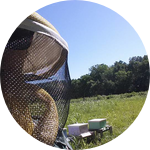About This Project
The honey bee is a charismatic species that plays a critical role in the pollination of agriculturally important crops and native flora. One emerging field of research is that of the host-associated honey bee microbiome, a group of bacterial phylotypes that are consistently found within the honey bee and are thought to play critical roles such as protection from pathogens and nutrient acquisition. As part of this project, we will investigate how these microbes communicate with each other.
Ask the Scientists
Join The DiscussionWhat is the context of this research?
The European honey bee is a charismatic species that plays a critical role in the pollination of agriculturally important crops and native flora. The recent and dramatic decline in the health of the honey bee has spurred researchers to both examine potential causes of the decline and identify factors that contribute to the well-being of this insect. One emerging field of research centers on the host-associated honey bee microbiome, a group of bacterial phylotypes that are consistently found within the honey bee and are thought to play critical roles. In other model systems, host-associated microbial communities are known to participate in a form of bacterial communication known as quorum sensing, which allows microbes to sense their environment and respond with changes in gene expression.
What is the significance of this project?
Nothing is known about quorum sensing by microbes within the honey bee host. This proposed project will investigate links between bacterial species and communication between them in the context of a host. To our knowledge, this is the first time that this line of investigation will be applied to the honey bee. Results will be critical to understanding the role of these microbes in promoting the health of the honey bee, but will also have broader implications for other host associated microbiota. Our preliminary studies suggest that these microbes interact with each other, promoting growth in vitro. If we are to understand the functions of the honey bee associated microbial community we will need to understand how these microbes interact with each other.
What are the goals of the project?
The overall goal of this project is to identify and functionally characterize quorum sensing within the honey bee microbiome. Towards that goal, and for this subproject, we propose to: identify and characterize signaling molecules produced by members of the honey bee microbiota. We will use microbes collected from the honey bee digestive tract that are representative of the major bacterial species found in the microbiota. These will be tested for production of quorum sensing signals and the type of signal will be characterized. As a result, we will identify which bacteria communicate within and between species. Ultimately, we hope to identify what bacterial behaviors are controlled by quorum sensing in the bee gut and how this may contribute to honey bee health.
Budget
It is important to emphasize that bacterial species do not exist in isolation; although studied in monoculture in the laboratory, their natural ecology includes other microbial organisms. One way bacteria communicate with one another is through a process referred to as “quorum sensing”. This communication allows bacteria to sense their environment and make population scale changes in behavior in response. Previously, we identified bacterial communication occurring in vivo within the honey bee gut. As part of this project, we hope to better characterize what signaling molecules are produced by individual microbes (cultured isolates).
Endorsed by
Meet the Team
Irene Newton
I am a microbiologist and faculty member at Indiana University in Bloomington, IN. I have been interested in symbiosis and in microbiomes for a long time and have been working on the bacteria associated with honey bees for over 5 years.
Kayla I Miller
I am a Ph.D. candidate at Indiana University studying Microbiology and Ecology. I am fascinated with microbes and how complex these ‘simple’ organisms can be. Specifically, I’m interested in how microbiomes interact with hosts and the consequences of these interactions. I’m excited to be researching one way bacteria interact with their hosts through quorum sensing, or bacterial communication. I’m hopeful that this research will help us better understand how bacteria affect the health of the honey bee and how it can be applied to other organisms.
Project Backers
- 51Backers
- 101%Funded
- $2,216Total Donations
- $43.45Average Donation


